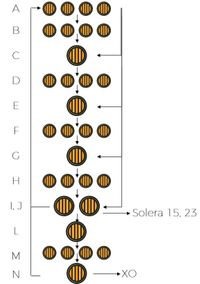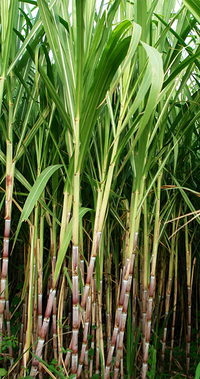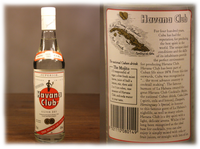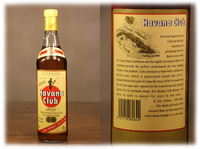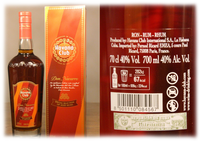Facts about Rum
Ageing
A blended rum indicates the youngest distillate, with a solera rum it indicates the oldest distillate. Even if the proportion is very small. In the case of whiskey, however, the most recent blend must always be specified.
Alcohol / Rum
Rum is just rum when it has minimum 37,5% alcohol. Below this limit it calls "rum liqueur".
Best selling rum
Leading rum brands worldwide in 2019, based on sales volume (in million 9 liter cases)
Blend / Single Cask
There are two different kind of rums: Blends and Single Cask. A blend is a mix from minimum 2 different distillates. Single cask rum is a rum from just one cask. That also means this rum is very rare and unique.
How rum is produced?
Sugar Cane
Rum stands out from other spirits such as whiskey and gin in that it is not based on grain and, like fruit brandies, is not due to a fruit. Instead, they rely on the raw material sugar cane. 9-15 months, sugar cane needs to grow up. It likes a lot of sun and much water and grows up to 3-6 meter. Thats why the caribbean and asian countries like Philippines and India are giving sugar cane perfect requirements.
More than 95% of the rum types from around the world are molasses rum. For this rum, the sugar cane is first crushed and pressed, and then the juice is boiled into syrup. Repeated decoction causes sugar crystals to form. As soon as the process is no longer profitable or further crystallization is ruled out, this sugar production step ends. A dark, syrupy mass remains, the molasses. It is the basis of molasses rum. This is the original raw material for rum. For centuries rum was made from molasses, but the decline in sugar production - due to the popularity of sugar beet in Europe - led to a bottleneck. | In the few countries - more precisely, the French Antilles - people turned away from molasses and began to distill fermented sugar cane juice directly. The is Agricole Rum. It is rum made from sugar cane juice, in which the sugar cane is grown and processed directly for rum production and often comes from our own cultivation or at least from the country of production itself. |
Fermentation
The next step is the mash. A mash is defined as crushed components or a liquid that is fermented. In the case of rum, it is molasses or sugar cane juice that ferments with the help of yeast. This process is the most important part, because this converts the sugar into alcohol through a chemical reaction. After around 2 days the mash is ready for the distillation. The alcohol content is around 5 to 10%.
Distillation
It is used in the production of rum to significantly increase the alcohol content of the liquid. The aim is 70-90% afterwards. The manufacturer can choose between two methods:
The pot still distillation (discontinuous distillation) includes a pot still and a long gooseneck for connection to the condenser. The kettle is fired directly or indirectly to heat the mash. The first burn cycle is followed by a second burn cycle. After this you have a distillate with over 20% vol. Alcohol content that is a little purer and whose middle course, the heart, is further processed. It does not contain any unwanted fluff, or only very little, but it does contain flavorings and alcohol. | The column still distillation (continuous distillation) makes it possible continuously pouring in and distilling mash, which means less effort and time and is advantageous for production in large quantities. A complete exchange of the mash is not given here. The alcohol obtained by heating and evaporation is a high 80%. Although more rum can be produced in this way and more even results are achieved, you lose some of the aroma. |
There is rum that rests only briefly in a steel container after distillation and is then reduced to its drinking strength with water and then bottled. This goes by the name of Blanco Rum or Rhum Blanc and is colorless in appearance. Such white rum (white rum) is young and unripened and is preferably used for mixing cocktails and long drinks. Brown rum is the opposite. The distillate moves into wooden barrels. Oak is always used, either American white oak or a European variety such as the Limousin oak from France. White oak rum barrels are the standard. In almost all cases, they have been filled with bourbon whiskey from the USA before. First they were burned out, then the bourbon was stored in them for at least two years, and then the barrels were shipped to the rum producers, because again they are not allowed to be used for the whiskey. The tiny remainder of liquid in the wood pores is released when the rum is stored and is expressed subliminally in the aroma and taste. A typical side effect is e.g. B. the soft sweetness of vanilla. Not only the type of barrel, but also the length and location of the storage of rum affect the result. The effect is greatest in a Caribbean / tropical climate, because just a few years are enough to make the distillate more complex, ripe, harmonious and rich in nuances. If a rum is (after) stored in Europe, the climate there has an influence on the character of the spirit. In general, the motto is that the longer a rum has been able to mature, the better it is. A premium rum can be assumed from 10 to 20 years of age. Not only the round, multi-layered taste and the unmistakable aroma, but also the color from straw yellow to gold and amber to mahogany, copper and brown is a result of the ripening of rum. The rum not only absorbs aromas from the wood, but the wood also removes unwanted substances from it. That is one more reason why long-matured rum is considered to be of high quality.
Blending
The vast majority of rums are blended. This means that several distillates are mixed together. This is done in order to get a uniform and satisfactory result that corresponds to the wishes of the customers. Blended rum is ubiquitous. The master blender is responsible for the blending and must have extensive knowledge of rum in order to know which distillates will lead to which end result and to what extent. Sometimes a blended rum takes the form of flavored rum or spiced rum if (natural) ingredients such as fruits or spices have been added during the blending process. The Solera Rum is related to the Blend Rum. It is stored or matured differently because it is a blend of short and long matured distillates. The Solera Blended Rum is a specialty and is not often produced. Even rarer is the single cask rum, which does not use any form of blending. Behind it are single barrel bottlings, in which the content of a single rum barrel is stored and bottled. A limited number of bottles and unmistakable enjoyment with recognition value are associated with this.
Bottling
After blending or after maturing in the barrel, it is first reduced to the desired drinking strength. The rum is mixed with distilled water to an alcohol content of more or less 40% vol. to obtain. 37.5% vol. is the minimum, prescribed drinking strength. If you do not dilute it, it is matured Cask Strength Rum, which goes into the bottle at barrel strength and around 60% vol. may have. Age information is part of the information on the label and is not mandatory. With a blended rum it indicates the youngest distillate, with a solera rum it indicates the oldest distillate. In the case of whiskey, however, the most recent blend must always be specified. Even if the proportion is very small.
Maestro Ronero
To become a Maestro Ronero you need decades of work and experience. He's the boss of the Master Blender. Most of the big distilleries like Havana Club, Bacardi etc. use it. He is often the figurehead of the big brands.
Master Blender
A master blender is an individual who develops specific blended spirits using a combination of spirits with different characteristics
Molasses More than 95% of the rum types from around the world are molasses rum. For this rum, the sugar cane is first crushed and pressed, and then the juice is boiled into syrup. Repeated decoction causes sugar crystals to form. As soon as the process is no longer profitable or further crystallization is ruled out, this sugar production step ends. A dark, syrupy mass remains, the molasses. It is the basis of molasses rum. This is the original raw material for rum. For centuries rum was made from molasses, but the decline in sugar production - due to the popularity of sugar beet in Europe - led to a bottleneck. |
Rum / Alcohol
Rum is just rum when it has minimum 37,5% alcohol. Below this limit it calls "rum liqueur".
Salary
Parts of the salaries at sea were paid in rum. Even during World War II, the British Navy tried to keep their soldiers happy with cheap rum. That lasted until 1973.
Sales market / Consumption
The largest sales markets are:
1. United States*
2. India
3. Philippines
*Havana Club has no access to the worlds biggest rum market. But sold the 5th most bottles in the world
Single Cask / Blend
There are two different kind of rums: Blends and Single Cask. A blend is a mix from minimum 2 different distillates. Single cask rum is a rum from just one cask. That also means this rum is very rare and unique.
Solera ageing method
Solera is an ageing method. The concept of the solera method is based on stacking multiple layers of aging barrels (called "criaderas") on top of each other, with each layer progressively topping up the next one down and blending with it, year after year. The word "solera" comes from the spanish word "suelo" which means "floor". The first layer of barrels in the solera agein process is sitting on the floor, and the rum extracted to be bottles aylways comes outfrom this bottom layer. When, a few times a year, the cellar master extracts the precious liquid from that base "solera" layer to bottle it, he willthen top up the bottom barrelsfrom the second layer itting above, and in turn from the third into the second, etc. until reaching the top, where new rum is added. Usually 10-15% of the volume of each barrel is transferred while performing this process, referred to in spanish as "saca" (from the verb "sacar" which means "drawing out".
The basic process has progressively evolved and, as running a traditional solera process can be quite expensive, we tend to see hybrid ageing methods developing in the industry. A good example can be found with Zacapa and their ever popular Solera 23 and XO rums. These are aged in a non-traditional solera method that features up to 12 steps, with some extractions even feeding back into higher layers in the process. One of the main benefits of the solera method is that generally helps producing more consistent rums year after year, while allowing to (technically) stll produce older rum year after year, as the rum from the oldest layer - also called the "Mother Rum" - is never bottled entirely. It also allows to produce greater quantitiesof old rum in a shorter amount of time, and some experts say it sweetens the rum process.
Sugar cane
Contrary to what was thought, sugar cane originally came from East Asia. In 1493 Columbus brang it to the Caribean. After 9-15 month sugar cane is ready for harvest and is 3-6 meters long. It is the main part of every rum. 70% of the sugar production comes from sugar cane. With the waste of the cane you can create molasses.
Types of rum (in Germany)
Original Rum - Imported original rum, sold unchanged (up to 74%) | Echter Rum - Like original rum, but reduced to drinking strength (min. 37.5%) with water |
Overproof Rum - Rum with an alcohol content above 57.15% | Blended Rum - Mixture of different original rums |
Rhum Agricole - It differs from normal rum primarily in that it is made from fresh sugar cane juice | Rum-Verschnitt - Mixture of rum and neutral industrial alcohol from other raw materials. In Germany, at least 5% of the alcohol in the finished product must come from rum |
Flavoured / Spiced Rum - Rum flavored in a corresponding process, at least 37.5% - with a lower alcohol content referred to as "rum-based liqueur" (examples: Captain Morgan Spiced Gold or Bacardi Oak Heart) |
Light Rum - Also known as white rum or silver rum, this style is aged in oak barrels and then filtered to remove color. Light rum is extremely popular as a mixer in Piña Coladas, Daiquiris, and other boat drinks | Gold Rum - Gold rum has a caramel color and a more pronounced flavor that silver or white rum. It is a medium-bodied rum, and you’re likely to find it blended into Mojitos or served straight up |
Dark Rum - Some dark rums are aged for many years and develop an intense flavor. Other dark rums are made via the same process as light rums, only they are not filtered. Dark rum is perfect for drinks like the tiki bar standby Mai Tai | Black Rum - The term “black rum” is sometimes used interchangeably with “dark rum.” Typically, though, black rum includes added molasses that darkens its color and sweetens the finished product. Black rum is the key ingredient in a Dark ‘N’ Stormy |
Cachaça - Made from fresh-pressed sugarcane juice, cachaça must be produced in Brazil and typically has a lower proof than rhum agricole. Though much cachaça is produced on an industrial scale, there are many artisanal producers who age their cachaça in indigenous woods |











